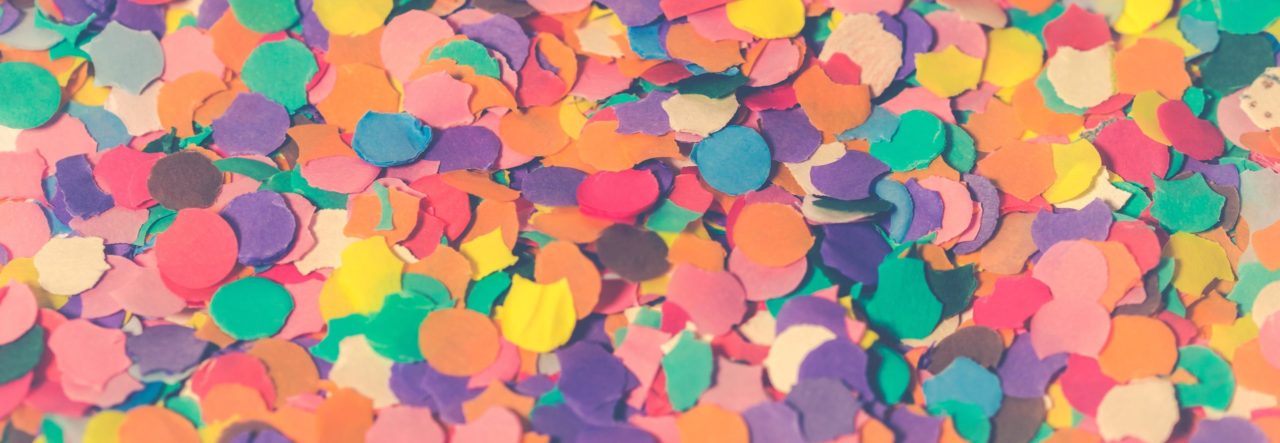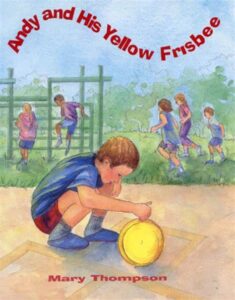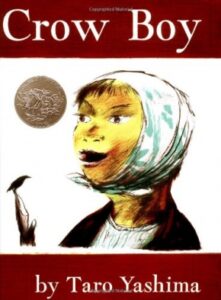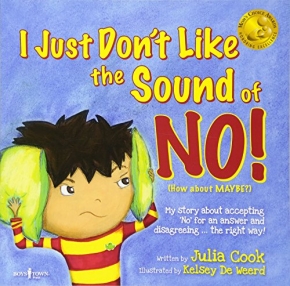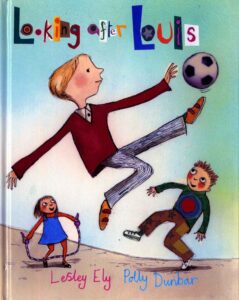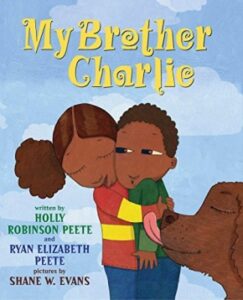This month’s Author/Illustrator Interview is with Kaz Windness, who—like me!—is a member of the PB23’s picture book group.
![]()
I’ve been watching the Herculean efforts she’s put into that group to support the work of other creatives, and that alone is worthy of kudos, praise, and deep-dish pizza. But wait…there’s more! She’s also an author/illustrator who’s created several picture books as well as Ready-to-Read books like Worm and Caterpillar Are Friends and Cat vs. Vac. Did I mention she created a book called Mother Goth Rhymes? And If UR Stabby?
Perhaps more important, Kaz is a dog person. Specifically “squishy-faced dogs.” And waffles. And all things Halloween. And thrifting.
And she has a black belt in TaeKwon-Do.
Are you ready to learn even more about Kaz? I sure am!
RVC: Let’s start with a really important topic that’s absolutely not the “correct” biographically chronological way to start an interview. How have you used your platform as an author and illustrator to advocate for neurodivergent individuals?
KW: Anytime anyone can be vulnerable and talk openly about their differences, it’s helps others gain confidence to be vulnerable, too. Neurodivergence is many things, not just autism, and I’ve found that talking about being autistic has helped others get their own autism or ADHD diagnosis, or feel confident in talking about their depression or anxiety. Maybe it’s the autism, but I don’t think any topic should be off-limits or closeted. I would much rather you told me about your trauma than about the weather or what you had for lunch—unless you had waffles, then tell me all about it! Point being, things that are hidden get twisted.
When we talk, we learn, we heal, and we understand ourselves and our world better. We also make connections, and the ND community is amazing!
RVC: Could you explain how your experience as an autistic individual informs your storytelling? How do you think this perspective contributes to the field of children’s literature?
KW: For one, children’s books are my special interest and always have been. Being passionate about children’s literature informs my understanding of good storytelling, what is happening in the children’s book market, and it inspires my art. Every book I create is plumbing my own psyche in some way, and that includes analyzing how being autistic in a world not designed for me has been difficult, but also how my specialness is something I cherish. I absolutely love hyper-fixating on a story idea or solving the best turn of phrase or figuring out the just-right color palette. Those are things that delight me as an autistic person, and that works out nicely for the line of work I’m in.
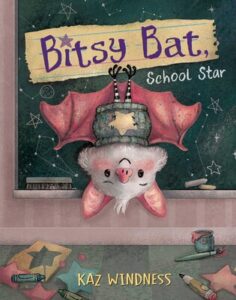 RVC: Your book Bitsy Bat, School Star (note the OPB piece on it right here! ) uses a bat to symbolize being autistic. How did you come up with this metaphor, and why do you think it’s an effective way to explain neurodivergence to children?
RVC: Your book Bitsy Bat, School Star (note the OPB piece on it right here! ) uses a bat to symbolize being autistic. How did you come up with this metaphor, and why do you think it’s an effective way to explain neurodivergence to children?
KW: Bats are a big special interest of mine and one of my favorite animals to draw. I created a couple cute and spooky bat picture book concepts, but my publisher wasn’t interested in Halloween books from me.
One day I struck up a conversation with one of my college illustration students–someone who is autistic like me–about growing up neurodivergent. I compared it to being like a bat in a school for mice. Everything can feel upside down, and when I tried to act like everyone else, it made me feel more confused, upset, and more prone to meltdown or shutdown. I began to realize bats were the perfect symbol for being autistic. “Bitsy Bat, School Star” gives voice to a character who is female-presenting and coded as a high-masking autistic. This specific perspective isn’t well-covered, but it’s applicable to many autistic children and relatable to any kid who has ever felt like they are different or misunderstood.
RVC: Thanks for the backstory with that! How important do you believe representation of neurodivergence is in children’s literature, and why?
KW: There are a lot of children’s books on the topic of autism. The number of books isn’t the problem. It’s who has been telling those stories and whose voices aren’t being heard that is what we need to work on. There is so much deeply harmful ableism in the world, so it’s important to let those who are of those group tell their own stories. We are infantized, talked over, and treated like we have a disease that needs a cure. (See also: eugenics.) I also want to take a moment acknowledge that black, brown, non-speaking and high support needs autistics need more room in this conversation, too.
RVC: Let’s go backwards now. Can you tell us a bit about your journey to becoming a children’s picture book author and illustrator? What inspired you to follow this path?
KW: We were a bookish household without a TV, and my mom read to us constantly. The moment I laid my eyes on Where the Wild Things Are by Maurice Sendak, I decided I was going to become a children’s book author and illustrator.
I went to art school for children’s book illustration and I teach at my alma mater. I also attended children’s book writing and illustrating conferences, entered portfolio showcase contests, and was discovered by my agent in NYC after 15 years of trying to figure out how to break in. I’m ready ready now.
RVC: Awesome! Now, what’s the story behind your first published picture book?
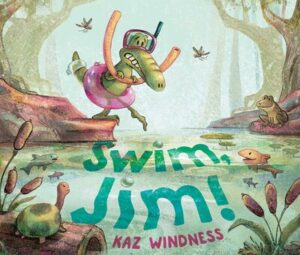 KW: Swim, Jim! is my debut authored and illustrated picture book. It came out last year and just won the Colorado Book Award for children’s literature. The idea came from seeing an article in the Miami Herald featuring a crocodile crossing a canal on a pool noodle. I drew a picture of him, and my agent said “write it!” so I did. It was rejected 65 times before going into auction and publishing with Simon & Schuster.
KW: Swim, Jim! is my debut authored and illustrated picture book. It came out last year and just won the Colorado Book Award for children’s literature. The idea came from seeing an article in the Miami Herald featuring a crocodile crossing a canal on a pool noodle. I drew a picture of him, and my agent said “write it!” so I did. It was rejected 65 times before going into auction and publishing with Simon & Schuster.
RVC: Wow, that’s persistent. What’s the most valuable lesson that experience taught you?
KW: One of the great things about it taking so long to get publishing momentum is I know who I am, what I want to say, and I have the confidence and experience to produce good quality work in a short amount of time.
RVC: How has your teaching experience at the Rocky Mountain College of Art + Design (your alma mater!) influenced your writing and illustration work?
KW: I’m for sure a better artist. Figuring out how to revise and improve what isn’t working in student work has applied directly to me improving my own work. I also just love teaching. The students inspire me constantly and are amazing people. I get to do my special interest all day.
RVC: Can you give us an insight into how you balance the text and illustrations in your picture books? How do they complement each other to tell the story?
KW: What they don’t tell you before you break in is that a lot of the direction the story takes, including how much text, how many pages, and general style direction, is a collaboration. As an illustrator-only, I generally prefer sparse text so the illustrations can do the heavy lifting for the storytelling. For a story like Bitsy’s, more text was needed, and I’m working with an editor that wants to make sure there is a lot of clarity for the reader in the text. It’s still my ideas and my voice, but I will be coached to clarify, explain, and add story beats. I still want the art to elevate the story and go beyond what the text is doing. Show, don’t tell. I’m always looking to distill the most important idea of the text into an illustration that makes you feel something.
RVC: Could you talk about how that happened with If UR Stabby, which isn’t exactly a picture book, but it’s funny. And stabby!
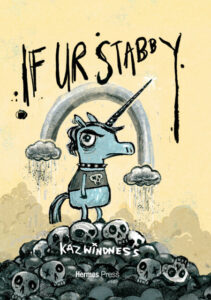 KW: “Allegedly” happened. I take the 5th. It’s not a children’s book, let’s be clear.
KW: “Allegedly” happened. I take the 5th. It’s not a children’s book, let’s be clear.
RVC: Fair enough!
KW: My publisher for Mother Goth Rhymes, Hermes Press, asked me for another book and said I could do whatever I wanted, so I did. Stabby is a lovable, cantankerous unicorn who deals with life the only way he knows how–horn first. It’s a humorous collection of comics, art parody, and tarot cards (you just have to see the book to understand), and it’s dark. It was cathartic for me to be creating Stabby during the pandemic, and it came out while we were still in the thick of it, so cathartic for others, too.
RVC: You’ve worked on various formats from picture books to graphic novels and early readers. How does your process differ for each one?
KW: Storytelling is storytelling. Almost always, I get the book idea from a sketch and I ask myself what story that character wants to tell, and then I go about writing it. I also don’t think panels are all that much different than any other kind of illustration composition, you just need to know how to use speech bubbles, and for early readers, get the story down into minimal words. Again, it’s another puzzle to solve, and I love solving word puzzles.
RVC: Your books are known for their character-driven narratives. What process do you follow to create such vivid and relatable characters?
KW: Can I offer a shameless plug instead of an answer?
RVC: Sure!
KW: I teach a class on this at CuddlefishAcademy.com. It’s called Hook! Plot! Pitch! and talks about premise hooks, plotting, and selling your books.
RVC: In your opinion, what elements are essential to create a great picture book?
KW: Honesty, heart. Books should be told with sincerity and by people who either care about children or are willing to be vulnerable about their own childhoods. This isn’t just not a side hustle, it’s a terrible side hustle. Don’t let those get-rich-quick TikTok’s fool you. If you are passionate about children’s books, that’s the “why.”
RVC: Tell me about a project or accomplishment that you consider to me the most significant in your career.
KW: Winning the Colorado Book Award for my debut written and illustrated picture book, Swim, Jim! was a real honor. An illustrator friend recently told me that they expect good an unexpected things to happen, and this was definitely one of those things for me. Here’s to more of that!
RVC: What about a time when things didn’t go the way you wanted?
KW: You are asking someone who took 20 years to break in. I will wear out my keyboard if I get into that here.
RVC: What trends have you observed in children’s publishing, and how do you feel they’re influencing the industry?
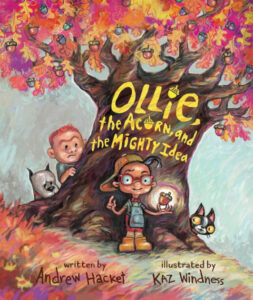 KW: We are all writing about what we recently experienced, so everyone is submitting grief books right now. I saw a trend in isolation and catastrophic storm books because as a metaphor for COVID and quarantine, and then I saw a trend in what I call “ampersand books,”—that is to say friend books like Worm and Caterpillar are Friends, because we were missing our friends and those narratives were wish fulfillment for renewed connections. I’m currently seeing a lot of tree books, and even have one coming out early next year (Ollie, the Acorn, and the Mighty Idea written by Andrew Hacket/Page Street Kids). Maybe it’s commentary on environmental concerns or the need for deep roots to survive—maybe both. I would caution authors not to follow trends. Instead, write the book only you can write. Dig into your psyche and pull out your truthiest truths, and tell that story. It takes way too long for a book to publish to ever be on trend. Be YOU.
KW: We are all writing about what we recently experienced, so everyone is submitting grief books right now. I saw a trend in isolation and catastrophic storm books because as a metaphor for COVID and quarantine, and then I saw a trend in what I call “ampersand books,”—that is to say friend books like Worm and Caterpillar are Friends, because we were missing our friends and those narratives were wish fulfillment for renewed connections. I’m currently seeing a lot of tree books, and even have one coming out early next year (Ollie, the Acorn, and the Mighty Idea written by Andrew Hacket/Page Street Kids). Maybe it’s commentary on environmental concerns or the need for deep roots to survive—maybe both. I would caution authors not to follow trends. Instead, write the book only you can write. Dig into your psyche and pull out your truthiest truths, and tell that story. It takes way too long for a book to publish to ever be on trend. Be YOU.
RVC: What advice do you have for aspiring authors and illustrators who want to break into children’s publishing?
KW: Get professional feedback. Get manuscript and portfolio reviews. Work with a critique group. You’ll get better, and you’ll get support. (CuddlefishAcademy.com offers coaching and critiques.)
RVC: One final question for this part of the interview. What’s something upcoming that you’re excited about, or really want to promote?
KW: It’s back to school time and Bitsy Bat, School Star is perfect for getting kiddos ready for school, and is a perfect ice breaker for first day of school, and it sets the year off right by recognizing the specialness of every child. Free lesson plans at www.BitsyBat.com!
RVC: Okey-dokey, Kaz. Let’s buckle down and get super serious because it’s time for THE SPEED ROUND! Wahoo! Sizzling swift questions and flappy fast answers, please. Are you ready?
KW: Yes!
RVC: Most misunderstood thing: UFOs, ghosts, or psychic abilities?
KW: Psychic abilities.
RVC: Pepperoni. Great deep-dish pizza topping, or the GREATEST deep-dish pizza topping?
KW: I love broccoli on pizza. Do with that what you will.
RVC: If you could have a conversation with your future self, what advice would you ask for?
KW: Tell me I won’t have to work this hard later on. Tell me that my books will eventually have their own momentum so I can spend more of my energy on creating them rather than promoting them. Tell me that the rock I’m pushing up this hill will eventually roll down the other side and not back onto me. I don’t know if that is advice, per se, but it’s what I would hope to hear.
RVC: A picture book writer (living or deceased) you’d LOVE to illustrate for?
KW: Illustrating is hard. That’s so much pressure! While I’d love to get a big commercial illustration gig, I am THRILLED when someone else illustrates my words. Heather Brockman-Lee just illustrated When You Love a Book (Viking/Flamingo Fall 2024) and that was a dream come true. I’m also a huge fan of LeUyen Pham and I would evaporate out of my body and become a cloud in the heavens if she illustrated one of my books.
RVC: Favorite LGBTQIA+ picture book?
KW: I’m super excited for Molly’s Tuxedo by Vicki Johnson.
RVC: Best thing a kid has said about your books?
KW: I’ve had a few people send me pictures of their kids taking my books to bed with them, usually falling asleep with them on their face. Those pictures are better testimonials than words.
RVC: Thanks so much, Kaz! Here’s hoping you can finally convince your agent and editor to let you draw a toilet in a picture book someday. Ah, to have super-duper scatological dreams….
KW: A toilet someday! Thanks for the opportunity!

